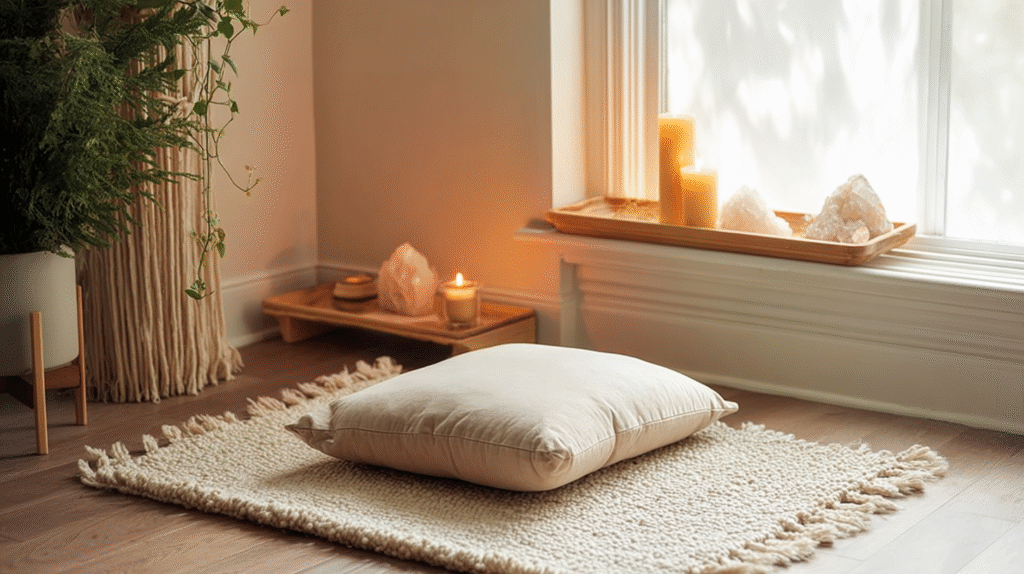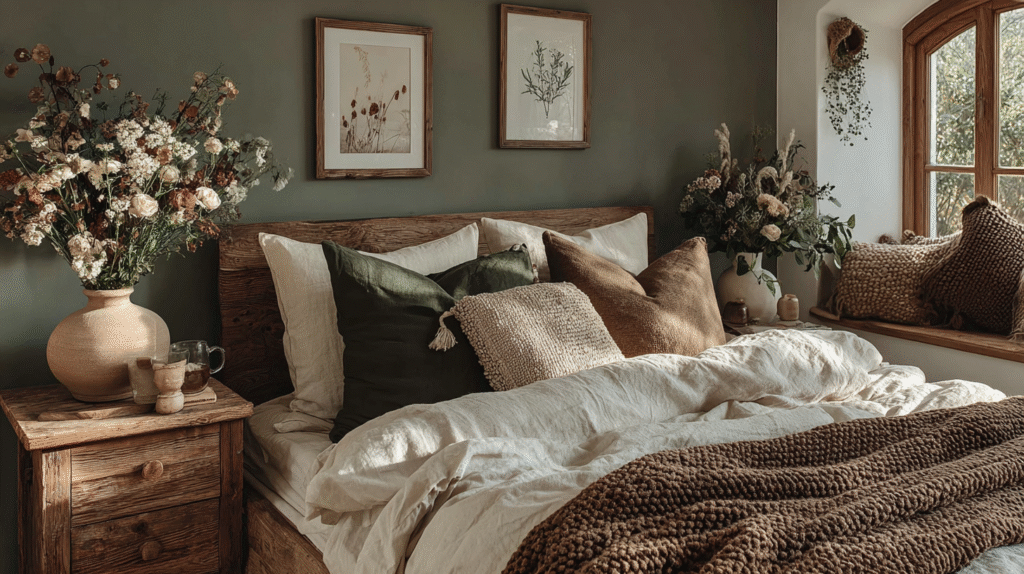This post may contain affiliate links, including those from Amazon Associates. If you make a purchase through these links, I may earn a commission at no additional cost to you. Learn more about our affiliate policy.
Some evenings, the day lingers in your body long after you’ve crossed the threshold of home. Shoulders tense, mind cluttered, you step into the bathroom and wish it could feel like more than a utilitarian stop.
With a few simple edits, this space can become a sanctuary, one that invites your nervous system to exhale and offers a ritual of care woven into daily life.
Why Create a Spa Like Bathroom?
The bathroom is often the only place in the home where solitude is possible.
It’s where water soothes, where scents linger, where the small act of closing a door can bring reprieve.
Designing this space with spa like intention doesn’t mean a full renovation. It’s about layering textures, light, and sensory details that shift how you feel in the space. These small, thoughtful edits add up to a ritual of restoration you can access every day.

1. Choose a Soft, Muted Color Palette
Color sets the tone immediately. Spa like spaces lean into calm shades like soft whites, warm beiges, muted sage, or gentle stone tones.
These hues quiet the eye and remove the sharp contrast that overstimulates.
Even if you can’t repaint the whole room, consider adding smaller accents in these colors: a linen shower curtain, pale towels, or a clay-hued bath mat. The atmosphere softens instantly.
2. Layer Lighting and Dimming
Overhead lighting can be harsh, especially in the evening. Instead, aim for layers of light. Warm bulbs, sconces, or even a small lamp can change the mood.
If you can, install dimmers for instant control. Candlelight is another layer that signals rest—placing a few in corners or near the tub allows the shadows to do the work of calming your nervous system.
3. Bring in Natural Textures and Materials
Bathrooms can easily feel cold with tile, porcelain, and glass dominating the space.
Balance this with natural textures: a wooden stool by the tub, a woven basket for towels, a stone tray to hold daily items.
These elements anchor the space with warmth and make it feel more grounded. When your hand grazes a natural surface, there’s a tactile reminder of simplicity.
4. Add Plants or Botanical Details
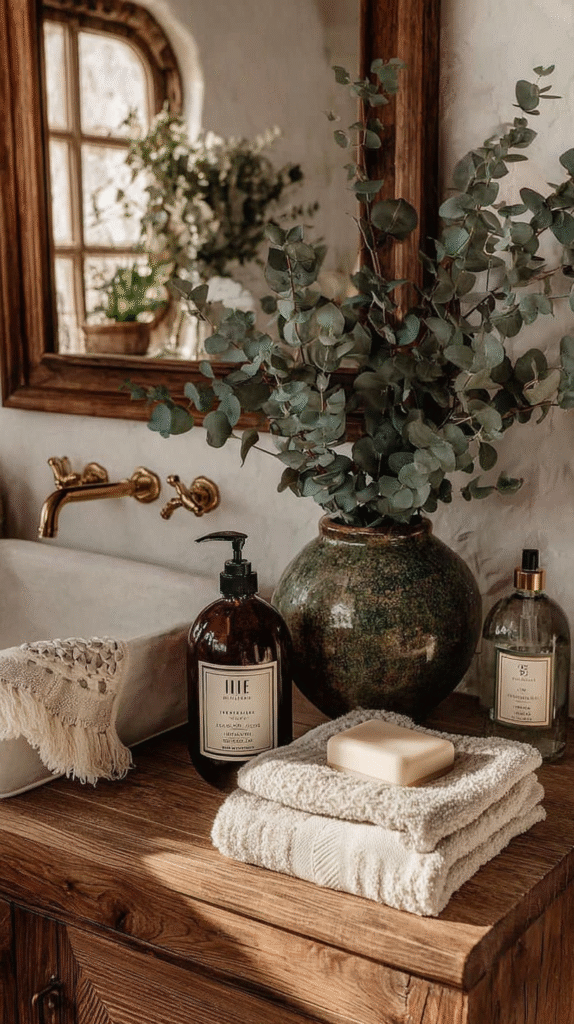
A living element softens even the smallest bathroom. Choose low light plants like pothos, peace lilies, or ferns if natural light is limited. A sprig of eucalyptus hung near the shower releases its scent with steam.
A small vase with fresh greenery on the counter can shift the entire energy of the room. Plants connect us to nature, and that connection naturally lowers stress.
If you’d like more inspiration on weaving greenery into small spaces, explore these ideas for easy indoor plants that elevate your earthy décor.
5. Keep It Minimal and Decluttered
Visual clutter quickly translates to mental clutter.
Clear the countertops, tuck away excess products, and leave only what you use daily in view. A few woven bins or hidden storage baskets create an immediate sense of calm.
A pared back bathroom doesn’t mean sterile, it means less noise for your mind to process when you step in.
For a simple system to maintain that sense of calm, you might try a 15-minute daily decluttering routine that keeps surfaces clear without feeling overwhelming.
6. Swap Textiles to Plush and Soft
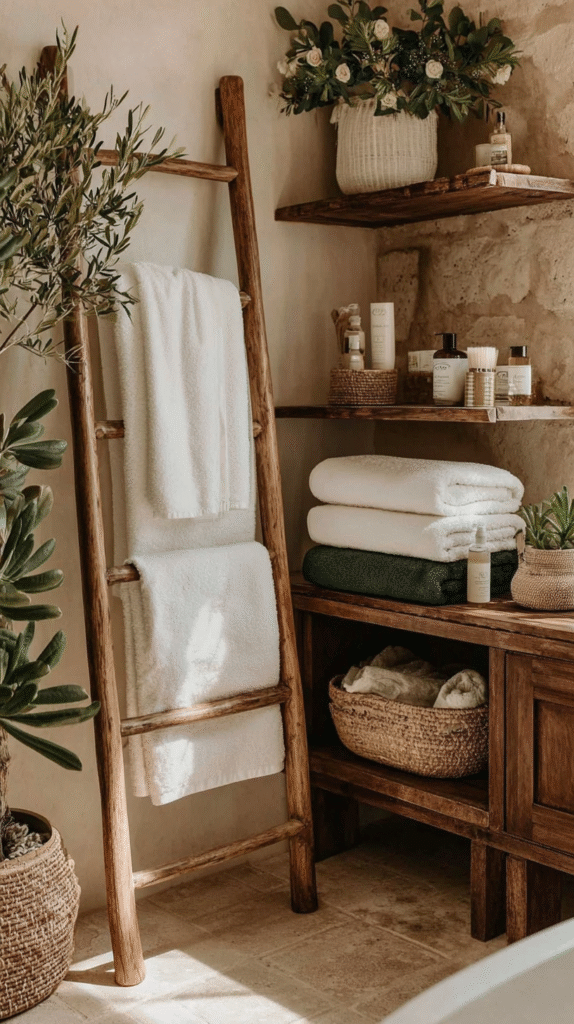
Towels and rugs are daily touch points.
Opt for thick cotton towels or a linen blend that feels breathable. Choose a bath mat that’s soft underfoot, adding a sense of grounded comfort.
Even replacing one set of towels with something more plush can make bathing feel like an elevated ritual instead of a routine task.
7. Upgrade Fixtures and Hardware
Small fixture swaps can have a big impact.
A rainfall showerhead, a matte black faucet, or brushed brass handles shift the space from basic to serene.
These changes often require little more than a screwdriver, but they alter both look and feel.
If a full upgrade isn’t possible, polishing or cleaning existing fixtures until they gleam can restore a sense of freshness.
8. Incorporate Aromatherapy and Scent Rituals
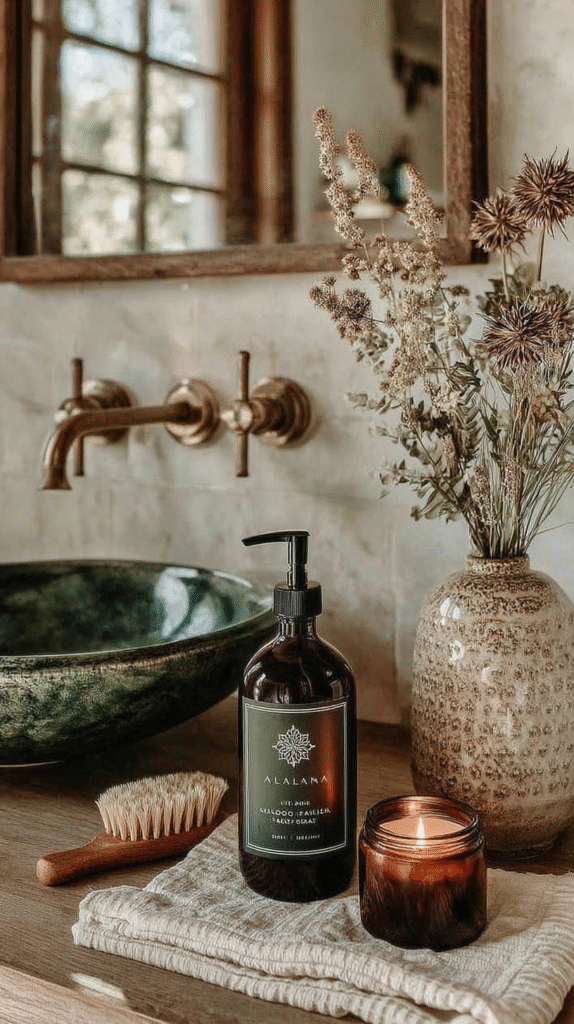
Scent has a direct line to the nervous system.
Essential oil diffusers, beeswax candles, or even a few drops of lavender in the bath can shift your mood in seconds. Keep a small tray of calming scents—eucalyptus, chamomile, cedarwood—ready to use when needed. Over time, your body will begin to associate these aromas with rest and renewal.
9. Introduce Comfort Underfoot
Hard tile doesn’t have to be the only option.
Pebble mats, cork flooring, or layered cotton rugs add softness and grounding. If you want more investment, consider heated flooring, but even a single plush rug in front of the sink transforms how you experience daily rituals like brushing your teeth or washing your face.
10. Use Thoughtful Mirrors and Reflective Surfaces
Mirrors affect not just function, but atmosphere.
A larger, frameless mirror reflects more light and expands the sense of space. Backlit mirrors create a soft halo effect that feels luxurious without being flashy.
If replacing isn’t possible, a simple cleaning and reframing can refresh the mirror you already have.
11. Create Restful Nooks and Touches
A stool to set down your tea, a bath tray with a book, or a small bench near the shower, these are details that say “you’re welcome to linger.”
Adding even one of these touches transforms the bathroom from a pass-through into a destination. It tells your body: this is a space for restoration, not just routine.
12. Layer Soft Sound or Gentle Silence
Sound is often overlooked, yet it shapes the nervous system profoundly.
A small waterproof speaker playing soft instrumental music or nature sounds can set the mood.
For some, true silence is more calming, achieved by adding sound absorbing textiles like a fabric shower curtain or extra rug. The goal is not performance, but a soundscape that lets you unwind.
If you’re looking to extend the same restorative atmosphere beyond the bathroom, this guide on creating a peaceful home that supports nervous system regulation offers deeper ideas.
Approaching the Spa Edit with Intention
The most important shift is not in the décor, but in the perspective. You don’t need to complete all twelve ideas at once.
Choose one or two that feel accessible right now. Notice how your body responds when you add a plant, when you light a candle, when you clear the counter. Each small edit is an invitation for your nervous system to settle.
Over time, these layers create a sanctuary you can step into daily, a place where the world’s noise quiets and your own breath becomes the rhythm of self care.

